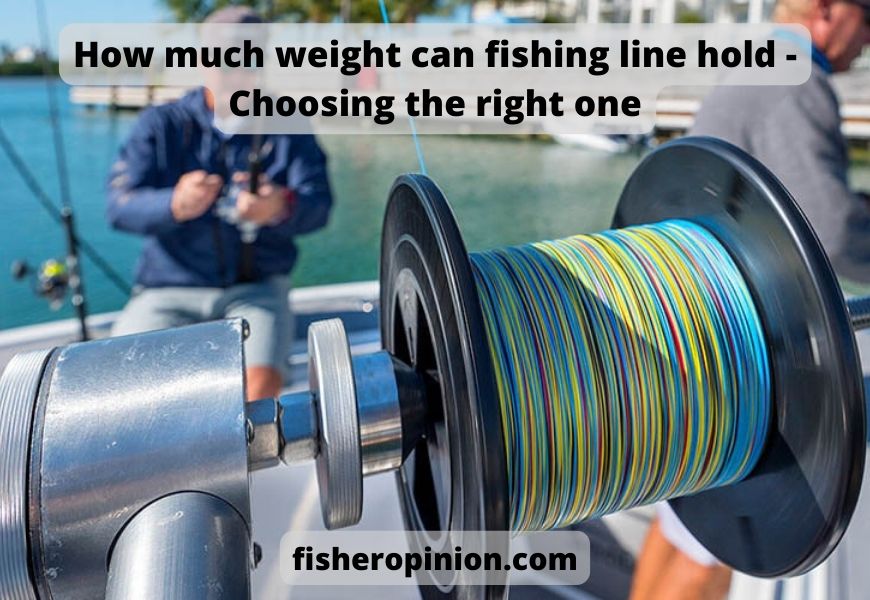How much weight can fishing line hold? Your angling experience can be made or broken by the fishing line weight capacity or the line test.
Understanding the limits of your fishing line is crucial for a productive day on the lake, regardless of your level of experience.
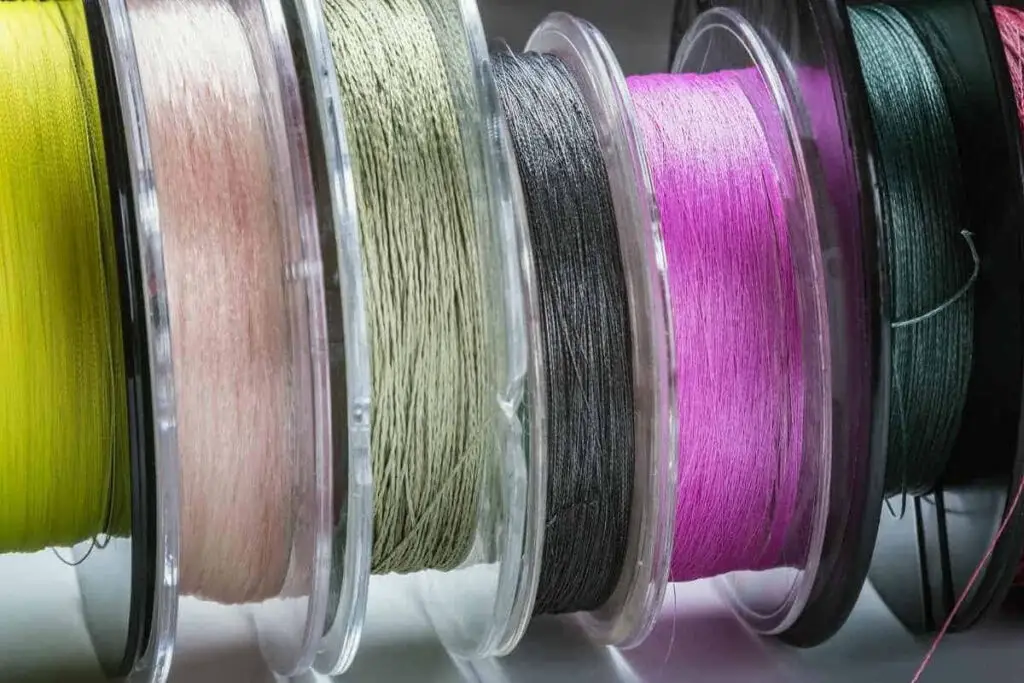
So, how much weight can fishing line hold?
Types of fishing lines
As varied as the fish themselves, the world of fishing line strength provides a variety of choices to meet the interests and demands of anglers.
Monofilament line
The monofilament line, also known as “mono,” is a well-liked and functional option. It is renowned for its adaptability, convenience, and affordability.
Since monofilament fishing line comes in a variety of pound test grades, it can be used for a variety of fishing purposes.
Fluorocarbon fishing line
Due to their near-invisibility underwater, fluorocarbon fishing line has grown in popularity.
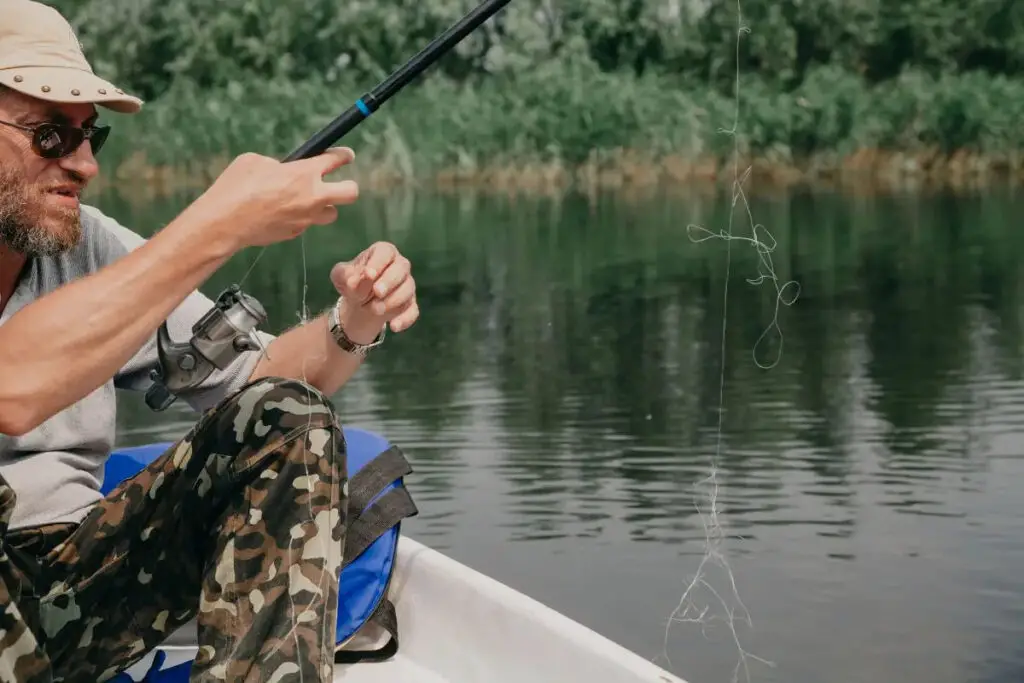
They are a great option in situations when fish are very picky or in clear water because of this trait.
These lines are renowned for resisting abrasion as well.
Braided fishing line
A braided line, also called a “braid,” is renowned for having a remarkable strength-to-diameter ratio.
Multiple woven or braided strands make up a braided fishing line, which is typically constructed of synthetic materials like Dyneema or Spectra.
High sensitivity, little stretch, and exceptional casting range are all features of braided fishing lines.
Copolymer fishing line
A hybrid choice that combines the greatest qualities of monofilament and fluorocarbon is copolymer lines.
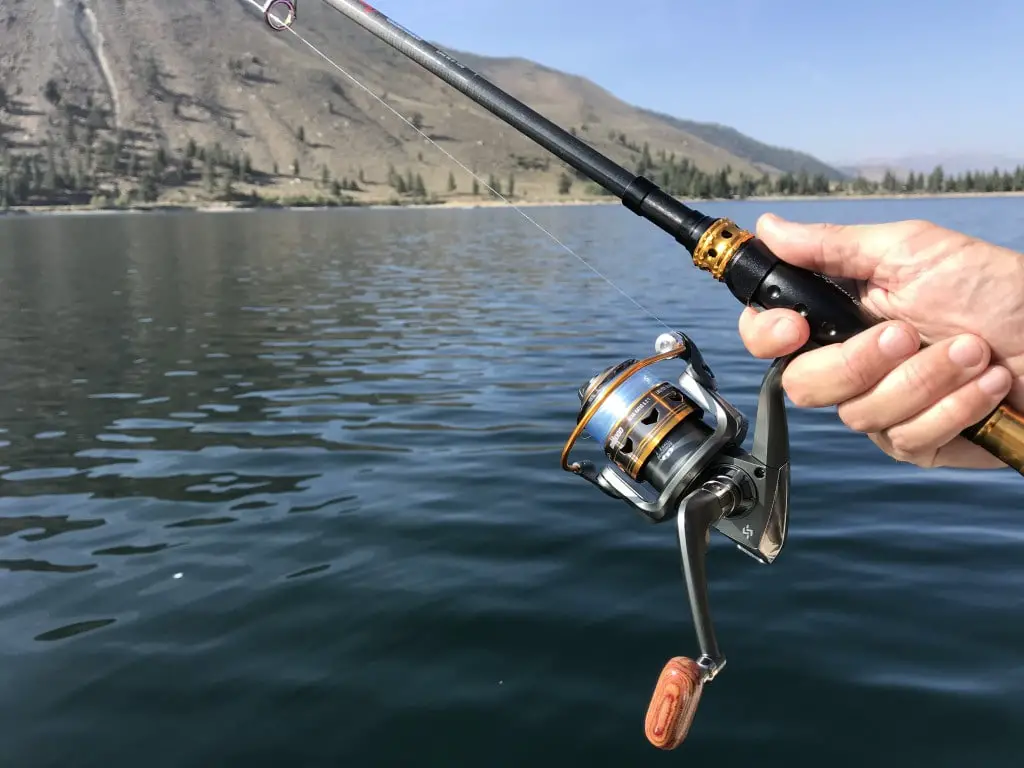
They offer some benefits of fluorocarbon, such as reduced visibility, along with the knot strength and flexibility of mono.
Differences in strength and durability
In order to choose the best fishing line for your unique needs, it is essential to understand the variations in strength and durability among several types of fishing lines.
In terms of performance and weight capacity, each type offers a unique mix of benefits and drawbacks.
How much weight a fishing line can hold depends on a variety of elements, including the material, diameter, and manufacturing process.
Monofilament fishing line has some elasticity and is typically more forgiving, which can help it withstand the stress of a hooked fish’s abrupt movements.
In contrast to a braided line, they could have a lower strength-to-diameter ratio.
The amazing strength of fluorocarbon lines in relation to their size is well known. They are excellent at resisting abrasion, but because they don’t stretch as much as monofilament, they may be less forgiving in some circumstances.
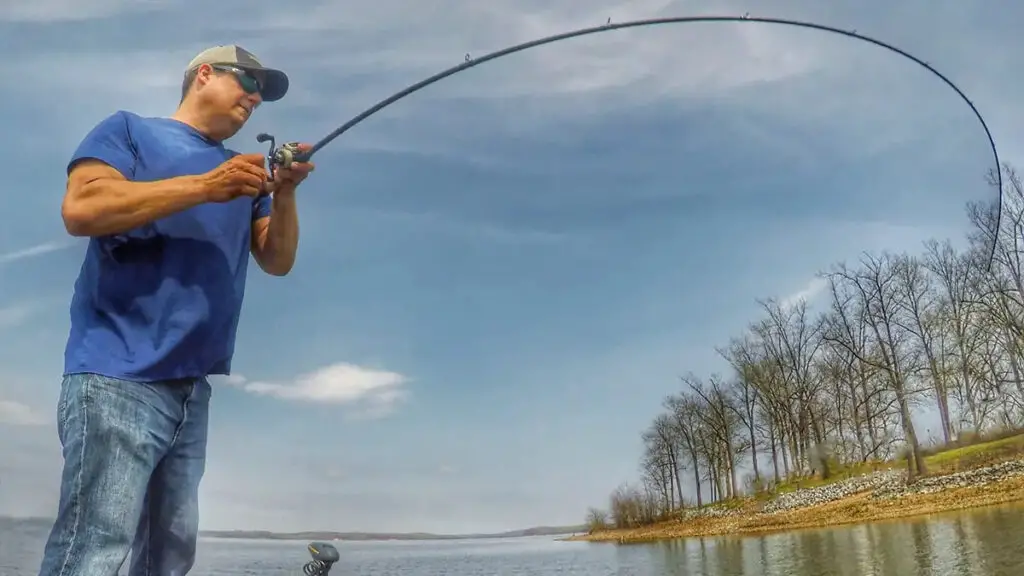
The strength of the braided line is unmatched and frequently exceeds that of monofilament and fluorocarbon lines of the same diameter.
The lack of elasticity in the braided line, however, might cause additional pressure on fishing equipment and may necessitate modifying your braided line fishing methods.
Due to their hybrid nature, copolymer lines provide a balance between the advantages of fluorocarbon and monofilament.
They might be stronger than a pure monofilament line, but they still have specific forgiving characteristics.
How much weight can fishing line hold?
Choosing the best fishing line for your unique needs and maximizing its performance on the lake requires an understanding of these aspects and how they interact.
Pound test ratings
You’ll frequently see terminology like “4-pound test line,” “8-pound test line,” or “20-pound test line” when perusing fishing lines. But what do these figures actually signify, and why are they so important?
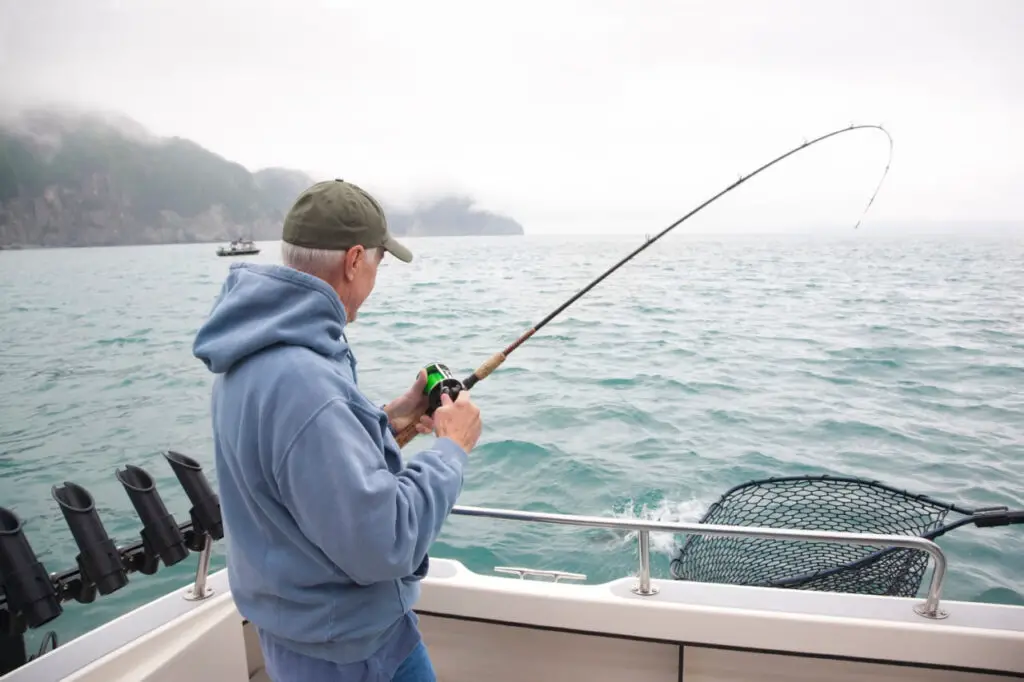
The term “pound test,” frequently shortened as “lb test,” refers to the maximum force that most fishing lines are capable of withstanding before breaking.
For example, an 8 lb test line should, in theory, be able to withstand an 8 lb force without snapping.
Factors influencing fishing line weight capacity
The pound test rating is a useful starting point, but the fishing line weight capacity is affected by a number of variables, all of which affect the overall efficiency.
Material
The strength of the fishing line is significantly influenced by the material from which it is constructed.
Monofilament, fluorocarbon, and braided fishing lines all have unique material characteristics that influence their pound test rating.
For instance, compared to monofilament lines of the same diameter, braided line, which is frequently produced from high-strength synthetic materials like Dyneema or Spectra, tends to have greater strength ratings.
Diameter
The strength of the fishing line is directly influenced by its diameter.
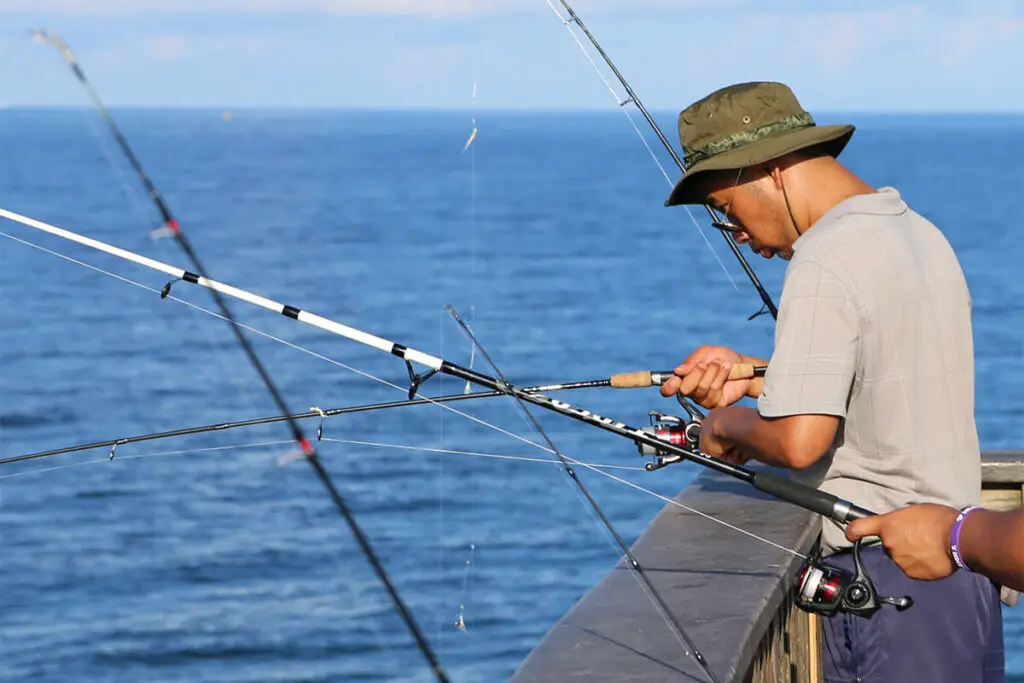
Generally speaking, thinner lines have a better strength-to-diameter ratio, which allows them to support more weight relative to their size.
When pursuing larger fish species, anglers frequently choose thinner lines to maximize sensitivity and casting distance.
Knot strength
A fishing line’s strength can be reduced by knots.
Some knots are more dependable than others, and different knot styles have diverse effects on strength.
Age and wear
A fishing line can deteriorate over time as a result of exposure to water, UV radiation, and normal wear and tear.
This can impair the line’s durability and increase the likelihood of a break. Utilizing a new fishing line is safer.
Stretch
A fishing line’s flexibility — or lack thereof — can affect line strength.
Due to the tendency of monofilament lines to have some stretch, abrupt movements by fish can be dampened.

Braided lines, on the other hand, have little flexibility, which can increase sensitivity but also put more stress on the equipment and knots.
Real-world applications
You can improve your angling experience by choosing your fishing line in accordance with your unique requirements and the fishing environment.
Crucial knowledge about fishing line weight capacity
For success in a variety of angling situations, it is essential to understand fishing line weight capacity.
Freshwater vs. saltwater fishing
The demands placed on a fishing line vary depending on whether it is used in freshwater or saltwater.
Fish are typically bigger and more powerful in saltwater, necessitating stronger lines.
Different species of fish
Different fish species exhibit different behaviors and degrees of strength.
A 10lb test line, for example, would be good for catching tiny bass but insufficient for larger predators like muskellunge or marlin.
Casting and lure selection
Your choice of fishing line is also influenced by the kinds of lures you use and the casting tactics you employ.
While bigger lures or deep-sea fishing may require thicker lines to manage the pressure, lightweight lures may need a lighter line to attain the appropriate casting distance and control.
Fishing conditions
Strong currents, wind, and uneven terrain are a few environmental conditions that might put additional strain on your fishing line.

Choosing the right equipment and making the necessary adjustments throughout your fishing trip can be made easier if you are aware of how these circumstances affect your line’s strength.
Selecting the right fishing line
To ensure you’re using the right fishing line for your intended use, consider the following tips:
- Research your target species: learn about the fish species you plan to catch, including their average size and behavior. This knowledge will guide you in selecting an appropriate pound test rating.
- Match power line & weight lure weight: consider the type of lures you’ll use and your casting techniques. Lighter lines are suitable for finesse techniques, while heavier lines are better for heavy baits and deepwater fishing.
- Consider the environment: evaluate the fishing environment, including water clarity, structure, and the presence of obstacles. In clear water, fluorocarbon lines with low visibility may be advantageous, while in snag-prone areas, durable braided lines could be a better choice.
- Check local regulations: some fishing areas may have specific regulations regarding the strength or type of the line.
- Carry a variety: anglers often carry multiple setups with different lines to adapt to changing conditions and fish preferences throughout the day.
- Regularly inspect and replace: fishing lines can deteriorate over time due to exposure to UV rays and wear. Inspect your line for signs of damage and replace it when needed to maintain its strength and reliability.
Tips for maximizing your fishing
By following these tips and incorporating proper maintenance and care into your angling routine, you’ll maximize the strength and durability of your fishing lines, ensuring they perform at their best when you need them most.
Preventing line breaks and extending line life
Here are some tips to help you maximize the line’s strength:
- Inspect regularly: before each fishing trip, carefully inspect your fishing line for signs of wear, nicks, or abrasions. Replace any damaged sections or the entire line if necessary.
- Set proper drag: adjust your reel’s drag system to match the pound test rating of your line and the size of the fish you’re targeting. This prevents excessive tension on the line during the fight.
- Use quality knots: learn and practice strong, reliable knots that won’t weaken your line. The right knot can significantly improve the knot strength and overall line performance.
- Avoid overloading: don’t overload your fishing line with more weight or force than it’s rated for. Respect the line’s pound test rating to prevent unexpected breaks.
- Reel in smoothly: when reeling in a fish, use a smooth and steady motion rather than jerky movements. This reduces stress on the line and minimizes the risk of sudden line breaks.
- Avoid line twists: line twists can weaken your line and lead to knots slipping or breaking. Use swivels or other anti-twist devices if needed, and ensure your line is spooled correctly on your reel to minimize twists.
Proper maintenance and care for fishing lines
Here’s how to ensure your lines stay in top condition:
- Store lines properly: store your fishing lines away from direct sunlight and extreme temperatures, as UV rays and heat can degrade the line. Use line spool holders or cases to prevent tangling and damage.
- Clean after use: rinse your fishing lines with fresh water after every fishing trip to remove salt, sand, and debris. This prevents corrosion and abrasion, which can weaken the line over time.
- Replace old lines: fishing lines have a limited lifespan, even with proper care. Replace your lines periodically, especially if they’ve been exposed to frequent use or harsh conditions.
- Use line conditioners: line conditioners and treatments can help maintain the suppleness and strength of your fishing lines. Apply them according to the manufacturer’s instructions.
- Avoid overfilling reels: when spooling your reel with a line, avoid overfilling it, as this can cause the line to bunch up and weaken. Leave a small gap between the line and the spool’s rim to prevent this issue.
- Rotate line: if you have multiple fishing reels, consider rotating your fishing lines between them. This prevents excessive wear on a single line and extends its overall lifespan.
Conclusion
When you’re wondering “So how much weight can fishing line hold?”, remember it isn’t just a matter of numbers; it’s a dynamic interplay between material, diameter, knots, and environmental factors.
FAQ
How strong is fishing line?
There are many strengths of fishing lines, which are commonly measured in pounds (lb). Depending on the type of line and its intended usage, the strength of a fishing line can range from a few pounds (for example, a four-pound test line for small-mouth bass) and 20–30lb (for sea bass) to well over 100 pounds for exceptionally big fish.
“Pound test rating,” a measure of a fishing line’s strength, denotes the maximum force the line may conceivably bear before snapping.
The strongest fishing line can support 130 pounds, according to the fishing line strength chart of the International Game Fish Association.
How strong is 30lb fishing line?
A fishing line with a 30lb line test is intended to endure about 30 pounds of strain before snapping. As a result, it works well for various freshwater and saltwater inshore fishing techniques, including medium to heavy fishing.
It is frequently used to catch larger fish like sea bass, which need a stronger line to withstand their size and power.
What is 20lb fishing line good for?
A fishing line test of 20 pounds is adaptable and can be utilized in various situations. It works well for medium-sized species like catfish, pike, and small-mouth bass.
Inshore saltwater fishing, where you can come across species like redfish and snook, is another activity that can be done with a 20lb line test. It is a preferred option among anglers because it strikes a favorable mix between strength and manageability.
Can you put 20 lb line on a 10 lb reel?
Yes, you can use a fishing reel made to handle 10-lb test lines with 20-pound test lines. On the fishing line spool, fishing reels are normally made to accept a variety of line strengths. A possible advantage is heightened sensitivity to the fish bite.
However, it’s crucial to take into account the reel’s capacity and the suggested line weights listed by the manufacturer in the fishing line strength chart.

